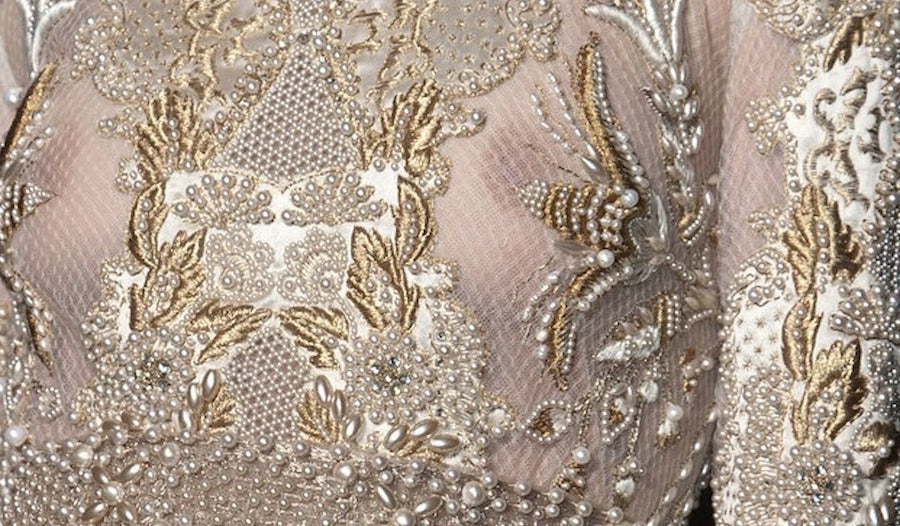
ANCIENT ALCHEMY
Image: Zardosi embroidery, Valentino haute couture
This week we are joined by Nidhi Garg Allen, an alumnus of Parsons School of Design and Adjunct Professor at the Fashion Institute of Technology. A technologist turned artisan entrepreneur, she is the founder and CEO of Marasim. Marasim emerged from Nidhi’s curiosity for the history and beauty of her own Indian culture, with craftsmanship and textiles her medium of inquiry. Based in New York, Marasim is now committed to preserving artisanal textiles that use regional techniques, without uprooting craftspeople from their native communities. Marasim designs and develops high-quality products, in collaboration with traditional Indian artisans, for luxury designers, such as Gabriela Hearst, Tory Burch, Oscar de la Renta, and Bode.
Text: Nidhi Garg Allen
For centuries, humankind has used rare metals, such as gold and silver, to adorn its textiles. India has long led the world in the variety and complexity of its gold embroidery and weaving traditions. Though it may often not be acknowledged, or even known, many of the gold embroideries seen on the international catwalks were developed in India.
A few years ago, I visited the shop of a young zardozi embroiderer in Hyderabad. In Persian 'zar' means gold, and 'dozi' embroidery, hence 'zardozi' is the term that describes embroidery in gold. This young man's grandfather had learned his technique as a child, and later became most renowned in the affluent circles of Hyderabad. I was inspired by his grandson's enthusiasm for, and pride in, the embroidery technique he had inherited. His mother, helping him at the shop, sensed my appreciation and invited me upstairs to show me the family's embroidery treasures. Sadly, I was not allowed to take pictures. Nevertheless, my eyes still sparkle at the memory of the gold and talent I saw that day. I remain grateful for the opportunity to take tea with, and hear the lore of, such a beautiful, humble family.

Image: Zardosi embroidery
The pandemic started just a few months after meeting that zardosi embroiderer, and so did our collaborative research and development. There are always some ingenious details that show up in the way he executes our designs.
But I was also keen to learn more of this craft's origin, its history, and its evolution. My curiosity led me to an extraordinary book (now out of print): Zardozi Glittering Gold Embroidery by Dr. Charu Smita Gupta. An excellent volume of research, the book also contains unique images of zardozi embroidery.
The craft of zardozi has a history that has continued through five thousand years. There is evidence from the Vedic age of artifacts embroidered in precious metals. However, zardoz, as a class of artisans, arrived from Persia to the Indian sub-continent in the twelfth century. Initially, their craft consisted of embroidery work in glittering gold and silver threads, and it survives today, moulded, and manipulated with the changing times.
 Image: John Lockwood Kipling, Zardosi workers in Delhi
Image: John Lockwood Kipling, Zardosi workers in Delhi
The book shares an origin myth, popular amongst the zardoz of Delhi, which runs as follows:
Once, a mosquito found the entrance to a king's head and gave him a severe headache. All options to rid the king of the mosquito failed. Finally, God appeared in the dream of a doctor, a Hakim. God told the Hakim that the resolution lay in hitting the king with a shoe in the area of the pain. The Hakim communicated the dream. A shoe embroidered with gold and silver threads was ordered for this purpose. The shoe did, indeed, kill the mosquito and free the king of his ailment. The king so admired the details on the shoe, he patronized its crafters, the zardoz.
Zardozi has since been enthusiastically adopted by the western world. The most famous example is, perhaps, the peacock dress, featuring beetle wings, worn by Lady Curzon at the Delhi Durbar in 1903. (I will return to the use of beetle wings for embroidery later this week.) When Cathy Hay created a sample in the original style, just a small section took her one year to complete. She calculated that it would take one skilled person around 30 years to recreate the whole dress. Hay visits the original dress and discusses her attempt to recreate it here.
My next article will explore more of the history this venerable craft.
